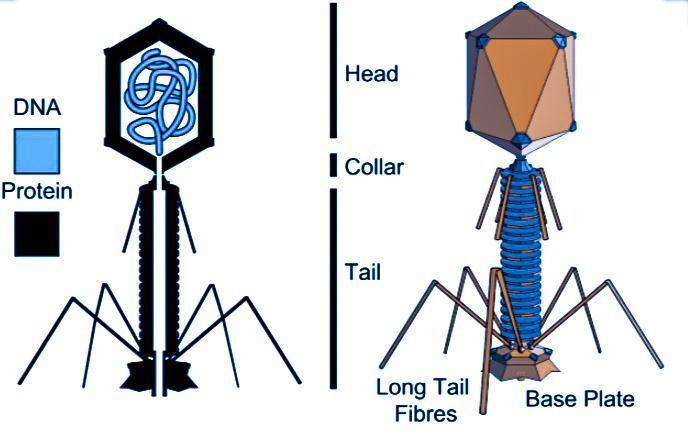
The single-stranded DNA is found in
A. TMV
B. ɸ×174
C. Poliovirus
D. Smallpox virus
Answer
573k+ views
Hint: It infects the Escherichia coli, and it was the first virus having a DNA-based genome sequence and were successfully assemn]bled in vitro.
Complete answer:
The phi ×174 or ɸ×174 is a bacteriophage virus which is a single-stranded DNA (ssDNA) virus. They have a positive circular DNA genome which consists of 44% GC-content and 95% nucleotides to code genes.
Additional Information:
- A bacteriophage is the group of a virus that infects the bacteria.
-The term bacteriophage was derived from “bacteria” and the Greek word phagein meaning “to devour “.
-The bacteriophage was first sequenced by Fred Sanger and his team in 1977.
-The physical structure of this virus was demonstrated by Walter Fiers and Robert Sinsheimer in 1962.
-It was the first virus used as a model to prove that DNA can be synthesized in a test tube by -Arthur Kornberg, a Nobel Prize winner.
-The transcription of bacteriophage was generated in 2020 with a series of four weak -promoters and four Rho-independent terminators and one Rho-dependent terminator.
-Bacteriophage virus encodes a total of 11 proteins.
-It has been used in many evolution experiments as a model organism.
So, the correct answer is “ɸ×174”.

Note: Virus is an infectious agent that multiplies only on the living cells of the animals. The TMV (Tobacco Mosaic Virus) is a positive single-stranded RNA virus mostly infecting tobacco plants and members of the Solanaceae family. The poliovirus is made up of RNA genome with the capsid made of protein. It is also a positive single-stranded RNA. The smallpox virus is a single linear double-stranded DNA. It was a communicable virus and caused serious infectious diseases.
Complete answer:
The phi ×174 or ɸ×174 is a bacteriophage virus which is a single-stranded DNA (ssDNA) virus. They have a positive circular DNA genome which consists of 44% GC-content and 95% nucleotides to code genes.
Additional Information:
- A bacteriophage is the group of a virus that infects the bacteria.
-The term bacteriophage was derived from “bacteria” and the Greek word phagein meaning “to devour “.
-The bacteriophage was first sequenced by Fred Sanger and his team in 1977.
-The physical structure of this virus was demonstrated by Walter Fiers and Robert Sinsheimer in 1962.
-It was the first virus used as a model to prove that DNA can be synthesized in a test tube by -Arthur Kornberg, a Nobel Prize winner.
-The transcription of bacteriophage was generated in 2020 with a series of four weak -promoters and four Rho-independent terminators and one Rho-dependent terminator.
-Bacteriophage virus encodes a total of 11 proteins.
-It has been used in many evolution experiments as a model organism.
So, the correct answer is “ɸ×174”.

Note: Virus is an infectious agent that multiplies only on the living cells of the animals. The TMV (Tobacco Mosaic Virus) is a positive single-stranded RNA virus mostly infecting tobacco plants and members of the Solanaceae family. The poliovirus is made up of RNA genome with the capsid made of protein. It is also a positive single-stranded RNA. The smallpox virus is a single linear double-stranded DNA. It was a communicable virus and caused serious infectious diseases.
Recently Updated Pages
Master Class 12 Business Studies: Engaging Questions & Answers for Success

Master Class 12 Economics: Engaging Questions & Answers for Success

Master Class 12 English: Engaging Questions & Answers for Success

Master Class 12 Maths: Engaging Questions & Answers for Success

Master Class 12 Social Science: Engaging Questions & Answers for Success

Master Class 12 Chemistry: Engaging Questions & Answers for Success

Trending doubts
What are the major means of transport Explain each class 12 social science CBSE

Which are the Top 10 Largest Countries of the World?

Draw a labelled sketch of the human eye class 12 physics CBSE

How much time does it take to bleed after eating p class 12 biology CBSE

Explain sex determination in humans with line diag class 12 biology CBSE

Differentiate between homogeneous and heterogeneous class 12 chemistry CBSE




